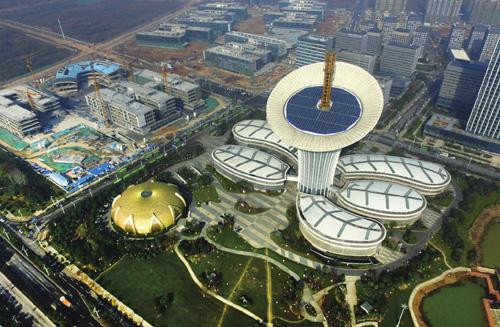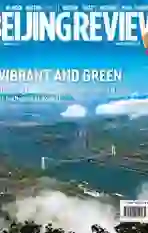GOLDEN WATERWAY
2018-05-22ByYuanYuan
By Yuan Yuan

The Yangtze River, winding through 11 provinces, autonomous regions and municipalities from east to west, is Chinas golden waterway. Protecting and improving the environment along the major waterway while developing the economy has been one of the top priorities of China.
“The Yangtze River is Chinas mother river, and we must protect it,” Chinese President Xi Jinping said during an inspection tour in Hubei and Hunan provinces in late April.
Xi called for achieving high-quality economic growth through developing the Yangtze River Economic Belt, which covers nine provinces and two municipalities and boasts a population of roughly 600 million that generate 40 percent of Chinas GDP.
He made the remarks at a symposium on promoting the development of the economic belt in Wuhan, capital of central Chinas Hubei Province, during his inspection to the area.
He stressed the importance of enhancing reform and innovation, strategic coordination as well as planning and guiding in developing the economic belt.
“It is a major decision made by the Central Committee of the Communist Party of China and a major strategy concerning overall national development to promote the development of the Yangtze River Economic Belt,” Xi said.
Going green
As Chinas largest fine phosphoric chemical maker, the Hubei Xingfa Chemicals Group is also the largest company relocated to the Three Gorges Reservoir region. Under a local government campaign against pollution in Yichang City, Xingfa closed, relocated or upgraded to clean industries a total of 134 chemical plants along the Yangtze River. It also closed down the port and plants near the Yangtze bank. Green vegetation was then planted on the site to restore the environment. Four sewage discharge outlets were shut down and the waste water now goes to a sewage disposal plant for further processing.
“Enterprises are the major force in protecting and building the ecological environment of the river,” Xi said when he visited the group on April 24. “We must move all polluting enterprises from along the Yangtze River with resolve... to root out the hidden dangers of pollution.”
Currently, the construction of the Wuhan North Lake sewage treatment plant is in full swing. The plant will be responsible for the concentrated treatment of sewage in the East Lake area. The short-term plan is to treat 800,000 tons of sewage while the longterm goal is 1.5 million tons.
Describing restoration of the rivers ecological environment as “an arduous task that the new era has entrusted to us,” along with “the high expectations of the people,”Xi called for top priority to be given to stopping unplanned development and capping the total pollution discharge. The restoration of the rivers ecological environment should be put high on the agenda in developing the Yangtze River Economic Belt, Xi stressed.
This is not the first time Xi has emphasized the importance and urgency of protecting the ecological environment of the Yangtze River Economic Belt. In January 2016, he held a symposium in Chongqing, a municipality along the belt, and put forward the principle of conducting large-scale protection and banning large-scale development.
Xi stressed and clarified this principle during his recent tour. “When we say there should be no large-scale development, it does not mean we cannot develop at all, but that we should stay away from the destructive development of the river and we should follow a green development path which puts ecology first,” he said.
“Xi made a thorough explanation of the major strategy for the development of the Yangtze River Economic Belt,” said Luo Laijun, an economist from Renmin University.“After the symposium in Chongqing, some people were puzzled by what ‘no large-scale development meant and what the limit of the scale should be. This time at the symposium in Wuhan, Xi gave a clear and precise answer.”
Luo said that Xis chairing of two symposiums on the development of the Yangtze River Economic Belt in 2016 and again in 2018, showed the great importance the Central Government has attached to this issue.
“This area has the most abundant ecological resources in China,” he said. “The protection of the environment here will benefit the construction of ecological civilization in the whole country.”
After Xingfa, Xi inspected the Three Gorges Project and the dam areas ecological environment. On April 25, Xi took a ship to inspect the ecological environment and development along the Yangtze River by visiting Jingzhou City in Hubei Province and Yueyang City in Hunan Province.
“The chemical companies along the Yangtze River and the restoration work on the ecological environment are the major concerns of the president during this trip,”said Hu Min, a researcher with the Chinese Academy of Governance. “Green development and high-quality development will be the theme for the area in the future.”
Wang Annan, an official from the Ministry of Water Resources, added, “Lakes are a very important part of the ecological environment along the Yangtze River. To protect lakes is to protect its ecological environment.”
Jingzhou has actively restored the ecological environment of its lakes and wetlands. By the end of 2017, there were a total of 24 newly emerged lakes in the city.
“In the past, many residents relied on fish farming to make a living,” said Huang Zehua, from the lake protection office of Jingzhou.“Fish farming then was mostly chaotic and disorderly. Now things are much better since many local governments along the Yangtze River rotate the fish farming and distribute the profits to individual households to promote ecological fishing.”
Jiang Shenghui, a villager from the Liangzi Lake area in Ezhou City in Hubei, said,“We used to do fish farming by ourselves in the lake but could hardly make any profits because the fish feed was too expensive. Now we dont have to worry anymore,” he said. “We get paid by spreading the fish farming area and this ecological fishing is good for restoring the environment.”
At the symposium in Wuhan, Xi said that the development of the economic belt must proceed from the long-term interests of the Chinese nation and put the restoration of the ecological environment of the Yangtze River high on the agenda.
“We must not allow the ecological environment of the Yangtze River to continue to deteriorate in the hands of our generation,”Xi said. “We must leave our descendants a clean and beautiful Yangtze.”
Chang Jinwen, an official with the Development Research Center of the State Council, said, “Rivers are the birth places of many civilizations. The Yangtze River Basin is the key ecological defense line of our country and its ecological environment protection is key to the development of the Chinese nation.
“We need to synchronize economic development and environmental protection,”Chang said. “This requires that all companies along the Yangtze River—no matter what industry they develop—make ecological protection a priority.”
Innovation and coordination
On April 26, Xi inspected FiberHome Technologies Group and Wuhan Xinxin Semiconductor Manufacturing Corp., two leading chipmakers in the Donghu New Technology Development Zone, dubbed“Chinas Optics Valley.”
As the worlds largest research and development (R&D;) and manufacturing base for optical communication equipment, the zone covers more than 500 square km and is now home to more than 20,000 technical talent from both China and abroad.
The FiberHome Technologies Group leads the world in R&D; and production of optical communication equipment of “ultralarge capacity, ultra-long haul and ultra-high rate,” with technology that can enable 6.75 billion telephone calls at the same time using a single optical fiber.
“Businesses must unceasingly make breakthroughs in core technology, mastering more key technologies with self-owned intellectual property rights and building up the ability to dominate industrial development. The country needs you to pick up the pace,” Xi said during his visit.
Xi then toured a national memory production base and assembly lines for integrated circuits at Wuhan Xinxin Semiconductor Manufacturing Corp., listening to reports about the smart manufacturing of chips and the progress of accelerating chip localization.
Comparing chips to the human heart, Xi said, “No matter how big a person is, he or she can never be strong without a sound and strong heart.” He urged businesses to make major breakthroughs in chip technology and challenge the heights of the global semiconductor industry.
Xi added that efforts should be made to improve the innovation system and boost innovation capacity. “To get core and key technology, begging for alms wont work,” he said. “We must rely on our own hard work.”
The president made five suggestions to promote the development of the Yangtze River Economic Belt at the symposium in Wuhan. One proposal involved “properly dealing with the relationship between individual development and coordinated development so as to make the economic belt an efficient economic entity.”
An Shuwei, professor of economics at Capital University of Economics and Business, described the different Yangtze areas, “The city clusters along the Yangtze River Delta area, the middle reaches of the river and the Chengdu-Chongqing area are three major growth poles along the Yangtze River Economic Belt and each one has its advantages and disadvantages.”
An explained that the Yangtze River Delta city cluster is the most developed, competitive and urbanized cluster in China. Yet the high population density in Shanghais central urban area, the low utilization rate of urban space and the deteriorating environmental conditions are a challenge to this area.
The city cluster in the middle reaches of the Yangtze has an excellent transport infrastructure, strong economic power and further urbanization potential. But it needs to improve the competitiveness of its cities and the coordinated development mechanism among the cities.
The Chengdu-Chongqing city cluster enjoys an advantageous location and a relatively high economic development level, which is important for the western regions development and strategic support of the Yangtze River Economic Belt. The challenges this region faces include increasing its low internal impetus, strengthening its weak innovation capacity and improving its infrastructure connectivity.
“In addition to curbing excessive exploration; limiting total pollution emission volume; and cracking down on deteriorating environmental activity; more efforts should be made to adjust economic structures and transform development modes along the belt,” said Wu Chuanqing, Director of the Center for Regional Economics Research at Wuhan University.
